Easter is all about sweets! As a chef, it’s important to stay up to date with all the latest food trends and incorporate holiday inspired dishes into your restaurant menu. In this blog, we are going to share some Japanese inspired Easter desserts.
Shaped like a baby chick, this is a perfect Eater dessert originating in Fukoka in 1912.
1. Before making the dough, scoop out 12 spoons of red bean paste, roll them into balls and let harden in the freezer for 30 minutes.
2. Mix egg yolk, Honteri, and milk in a bowl. Add flour, baking powder, salt, and knead until a soft dough has formed. Cover the bowl and refrigerate for 30 minutes.
3. Once done, divide dough into 12 pieces, roll each piece into a ball and press flat to create a round shape, big enough to be wrapped around the red bean paste ball. Once the paste has been covered with the dough, thaw to ensure quick and easy shaping.
4. Roll each bun in your hand creating a cylindrical shape. Squeeze one end to form the neck of the chick and shape the face and length however you like.
5. Bake the dessert at 300C for 15 minutes. Once golden brown, remove from oven, decorate the chicks, and serve. Eyes and wings can be created by using a heated steel chopstick or skewer.
This dessert consists of edible gems or rocks that are jelly on the inside and crystalised sugar on the outside.
1. Dissolve Agar Agar into water and bring to boil. Add sugar and let the mixture boil for a further 2-3 minutes.
2. Take the mixture off the heat and add flavouring. Pour into an oiled container, add a few drops of food colouring and swirl together.
3. Refrigerate the mixture for a few hours. Once set, pull it out of the container and cut into 1 inch crystal shapes. You can serve them fresh without the formation of crystal on the exterior or wait for 24 hours for the sugar to crystalise.
A great vegan option, this matcha chocolate egg consists of a matcha mousse filled in a thick chocolate shell, draped in white matcha chocolate.
Melt all your ingredients in a bain marie, on low heat. Once melted, leave the mixture to cool until its slightly thickened and pour into the egg moulds.
1. Fill the mould fully without overflowing. However, if it overflows, ensure to scrape away all the excess chocolate. Carefully place the mould in the freezer for 10-15 minutes to create 1cm thick chocolate.
2. Carefully remove the moulds from the freezer, turn the moulds upside down and let the remaining chocolate drip in a bowl. Once emptied, check the thickness of the hardened chocolate. If it’s too thin, add the chocolate again and freeze for another 20 minutes – or if it’s too thick, scrape the excess off.
3. Once you’re happy with the thickness, place the moulds in the fridge.
1. Blend all ingredients in a high-speed blender. Remove egg moulds from the fridge and pour the mousse in them until almost full. Place them back into the fridge for 3 hours, to set the mousse.
2. Melt all the excess chocolate that was poured from the shells and add it into a piping bag. Take out the moulds from the fridge and carefully remove the chocolate eggshells – once fully out, place half back into the mould.
3. Start piping around the outer rings of both shells with the melted chocolate and quickly and firmly close them together. Cover again with mould and place in the freezer for 5 minutes.
1. Melt all ingredients on low heat, in a bain marie. Mix in matcha powder and transfer the mixture into a silicone pouring jug. Once cooled at room temperature, remove the egg from the freezer, place it on top of a mason jar and pour the matcha chocolate on top to create drips, from a 30cm height. Once done, your matcha chocolate egg is ready to be served.
We hope you enjoyed learning about Easter dessert recipes inspired by Japanese cuisine. Replicate the dishes with Mizkan Chef’s specially crafted ingredients to add an extra touch of flavour to them. Sign up to our newsletter for all the latest news and updates within the Japanese food service industry and check out our chef recipes page for more Japanese and fusion cuisine inspiration.
Honteri is Mizkan Chef’s specially crafted ingredient that is similar to mirin, but with lower alcohol content. Chefs can use this seasoning to add an umami flavour, mild acidity, or sweetness to a variety of dishes.
Let’s learn what this versatile product is made of, its various uses and which dishes chefs can replicate for their own restaurants.
Honteri is an authentic mirin-style sweet seasoning, the only difference is that the former contains only 0.5% alcohol, meaning it’s easier to use than mirin, which requires boiling for the alcohol to evaporate.
The seasoning can be added to both sweet and savoury dishes. Chefs can use it as a direct sugar replacement for sweet dishes or add a small quantity to savoury dishes for complex sweetness and subtle umami taste. This is a quicker and easier alternative that will give chefs the depth of flavour they’re looking for.
The complexity and deep flavour of Honteri comes from its ingredients. The seasoning is made of:
Honteri mirin is used in many ways, in many different dishes, for example:
Our recipes page has plenty of unique recipes containing Honteri, created from our experienced chefs. If you’re looking for inspiration as to what dish you should try to replicate or incorporate in your restaurant menu, here are our top favourites:
Starter: Peppercorn Pork & Pickled Apple Yakitori
These pork skewers are a perfect starter to feature on your restaurant menu. Glazed in a sweet and savoury sauce, containing Honteri, this dish is a Japanese street food classic.
Main: Glazed Chicken Thigh with Black Sesame & Green Onion
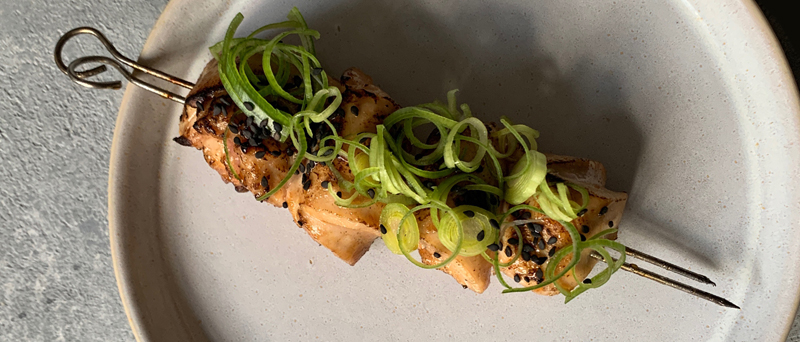
This chicken skewers dish is simple yet flavourful. Particularly fitting for a summertime menu, the pairing of Shiragiku vinegar and Honteri gives this dish umami overtones that Japanese cuisine lovers will surely appreciate.
Dessert: Fluffy Japanese Souffle Pancakes
Finish off a three-course meal with delicious Honteri-flavoured Japanese pancakes. The seasoning isn’t only added to the pancake mixture, but also used as a sauce to mask the redcurrant’s sour flavour – a perfectly balanced dessert great for breakfast, lunch, or dinner.
Drink: Honteri Martini
If you’re feeling extra creative, why not add a little Honteri touch to your drinks menu? With just a few simple ingredients, you’ll have unique cocktails rounded with depth of flavour and sweetness.
Are you ready to make Honteri your secret weapon and keep customers coming back for more? Get in touch with our team for details on how to purchase the product. Alternatively, sign up to our newsletter for all the latest news, updates, and trends within the Japanese foodservice industry.
Sushi is a traditional Japanese dish popular across the world, mainly made of raw seafood and vegetables accompanied by steamed vinegared rice.
This blog post will inspire chefs to make unique vegetarian sushi dishes catered specially for vegetarian customers that love Japanese cuisine.
Let’s explore two exciting vegetarian sushi recipes that can be added to your restaurant menu.
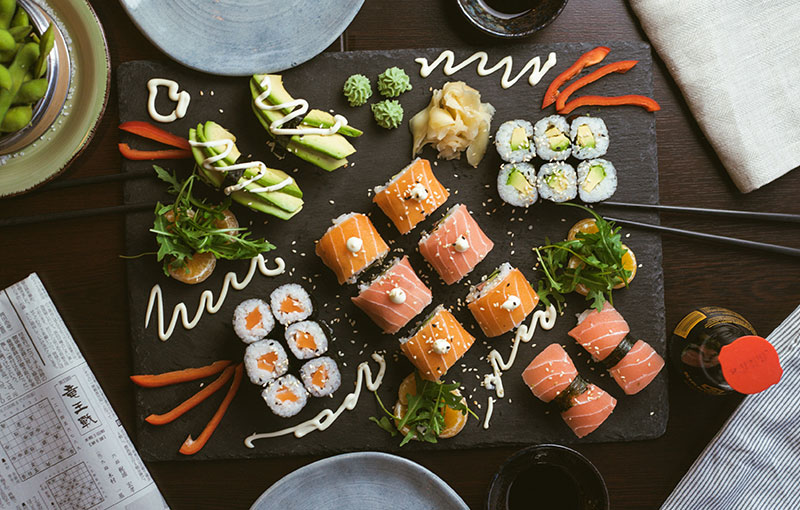
As a chef, it’s important to craft your own identity and experiment with things that aren’t traditional, for example, creating an aubergine sushi dish.
2. Toast sesame seeds until golden and crush them once cooked.
3. Prepare marinade for aubergine: mix sesame oil, soy sauce, rice vinegar and crushed sesame seeds and set aside.
4. Cut the aubergine vertically, salt both sides of each half and set aside for 60 minutes. Rinse the salt and dry the slices with a paper towel.
5. Heat sesame oil in a pan, add aubergine halves and allow them to cook and char on each side for 5 minutes. Once cooled, cut them into long strips and coat in the marinade prepared earlier.
6. Vertically slice carrots and cucumbers.
1. Wrap sushi mat in cling film. Place nori sheet on top of the mat, rough side upwards.
2. Evenly spread sushi rice on the nori sheet, leaving a 1cm margin at the top for sealing. Press the rice down into the mat with the back of a spoon.
3. Place all the filling ingredients in the middle of the nori sheet. Roll the sheet using the mat, squeezing tightly to make sure everything is bonded. When reaching the end of the roll, brush water on the margin left to seal properly.
4. Cut the roll into 5 pieces and serve with the leftover marinade or soy sauce.
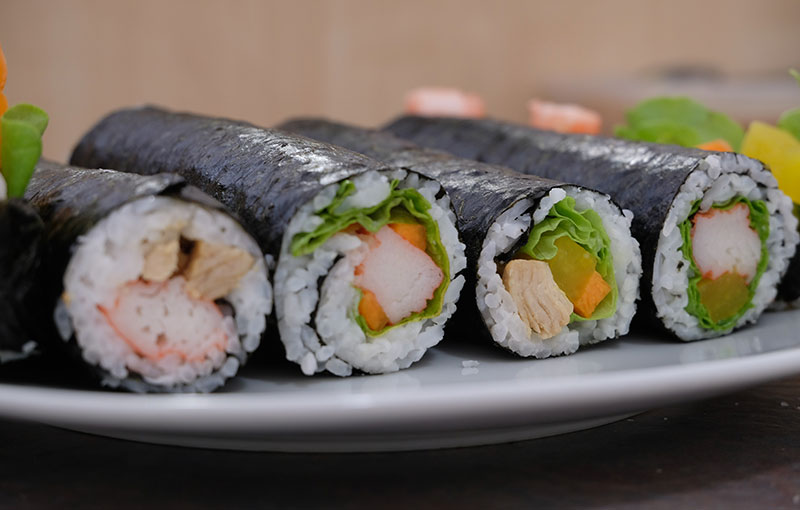
Break tradition with another exciting vegetarian recipe that will appeal to customers that not only love sushi but also enjoy trying unusual new dishes.
1. Rice seasoning preparation: mix vinegar, honey, sugar, and salt.
2. Coconut batter preparation: mix flour, cornflour, salt, carbonated water, ice cubes, coconut, and breadcrumbs.
3. Rice preparation: mix quinoa and water in a pan on medium heat and bring to boil. Reduce heat and simmer for 20 minutes. Add half of the rice seasoning into cooked quinoa and spread a thin layer onto a cutting board and let it cool for 10 minutes. Turn it over and cool for 5 more minutes and set aside in a non-metal bowl, covered with a damp cloth.
4. Drain excess moisture from the tofu and cut vertically. Lightly dust with cornflour and coat with coconut batter. Fry until golden brown on all sides.
5. Thinly slice all other vegetables and wrap all the ingredients together using the same rolling method mentioned above.
We hope these two unique recipes have sparked some inspiration for the next time you’ll be developing a vegetarian sushi dish for your restaurant.
For further information on the products mentioned in the blogpost, please get in touch with us or sign up to our newsletter for all the latest recipes, news and trends related to Japanese cuisine.
Japanese cuisine has an extensive range of sauces that can go well with a variety of dishes. From all-purpose sauces such as miso sauce to sauces that are perfect for grilling like Yakiniku sauce or those that go well with deep-fried dishes such as Tonkatsu.
Let’s explore three Japanese sauces that are extremely popular in Japan due to their versatility as they have a base flavour that complements many different dishes. Learn how chefs can recreate these sauces using Mizkan Chef’s specially crafted ingredients.
This classic citrus-based sauce can be used in a variety of ways such as:
Beyond adding a citrusy and tangy taste, ponzu sauce brings an umami flavour and subtle sweetness into dishes. Let’s find out how chefs can create the sauce using our high-quality ingredients.
Ingredients:
Preparation method:
1. Mix Honteri, rice vinegar and bonito flakes over medium heat and simmer.
2. Remove from heat and add konbu. Once cooled, strain the liquid to remove bonito flakes, keeping konbu.
3. Add citrus juice and the ponzu sauce is ready to be served.
Tonkatsu sauce can also be used alongside deep-fried dishes such as karokke, chicken katsu and katsu udon.
Let’s learn how chefs can make this sweet and tangy flavoured sauce using Mizkan’s ingredients for extra depth and flavour.
Ingredients:
Preparation method:
1. Mix all ingredients together in a bowl.
2. Refrigerate for 24 hours to combine all the ingredients and achieve a deeper flavour.
3. Serve with any deep-fried dish of your choice.
Lastly, we have yakiniku sauce, which is a Japanese BBQ sauce used alongside grilled foods including meats, vegetables, and seafood.
Due to the variety of both sweet and savoury ingredients, this dark-golden sauce has a sweet and savoury flavour – making it perfect for grilled dishes.
Let’s find out how chefs can make it for their restaurants.
Ingredients:
Preparation method:
1. Mix sake, Honteri, sugar, rice vinegar, soy sauce, bonito flakes, garlic and ginger in a pan on medium heat and stir until sugar is completely dissolved. Make sure to stir constantly to prevent sugar from burning. This should take around 3 minutes.
2. Turn off the heat and strain the sauce to remove garlic, ginger and bonito flakes.
3. Add sesame oil, toasted white sesame seeds and apple juice to the strained sauce, mix together and serve either as a dipping sauce or pour over the dish.
Now that you know the three traditional Japanese sauces that are a staple within Japanese cuisine, recreate them to be served alongside fusion and Japanese dishes in your restaurants.
Learn more about our high-quality products through our FAQs page and get in touch with us for any further queries about purchasing the ingredients for your restaurants.
You can also sign up to our newsletter to be kept up to date with all the latest industry news.
What is Japanese cuisine without its noodles? The product, which was first introduced as a luxury food in Japan, is now extremely popular across the world.
Their versatility makes the food so popular; they can be served hot and chilled; added to soups and stir fries and enjoyed with dipping sauces and salads.
This blogpost will guide fusion chefs through the different Japanese noodles, what they’re made of, and how to incorporate them in popular noodles dishes.
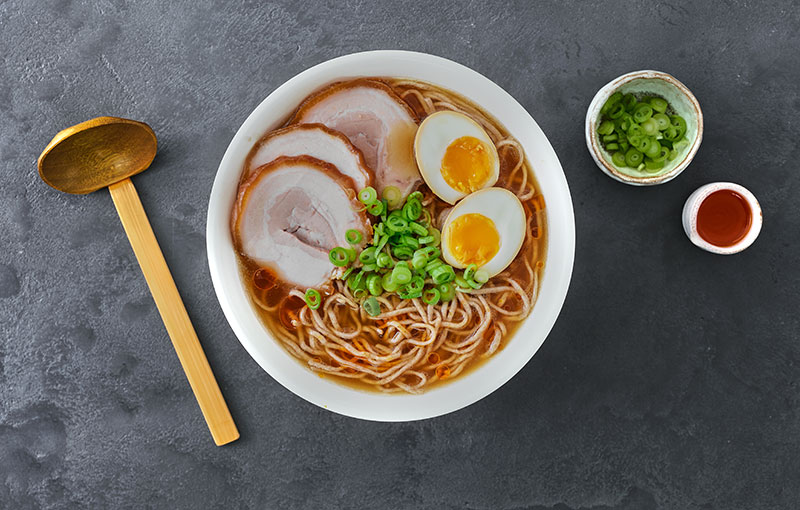
Ramen noodles are the most popular type of noodles in Japanese cuisine, and their shape, length and thickness vary by region. They have a light-yellow colour, firm texture and are mainly served in broths and soups such as Ramen Tonkotsu Soup.
Let’s explore Japan’s most popular ramen dishes:
Ramen noodles have four main ingredients:
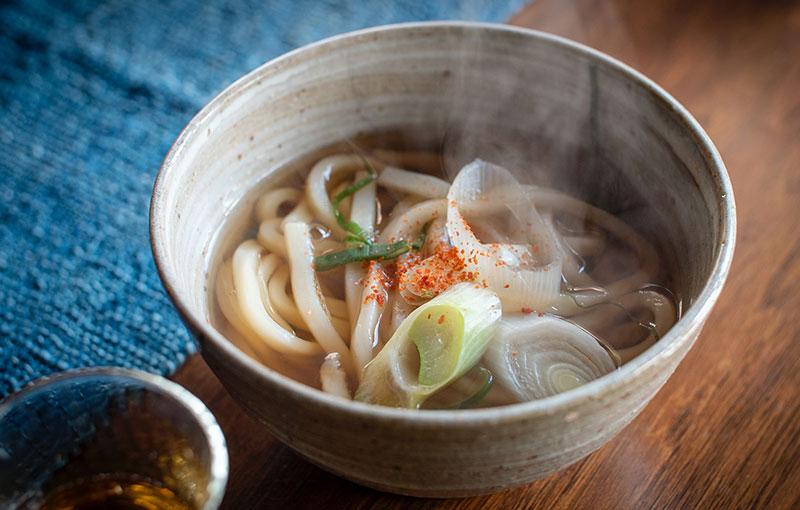
Udon noodles are white, thick, chewy noodles also commonly used in soups and broths. They can be served both hot in soups such as vegetarian udon soup and stir-fries, or chilled with dipping sauces and salads.
There is a huge list of hot and cold dishes that vary regionally – however some of the most popular udon dishes are:
Udon noodles are made of the following ingredients:
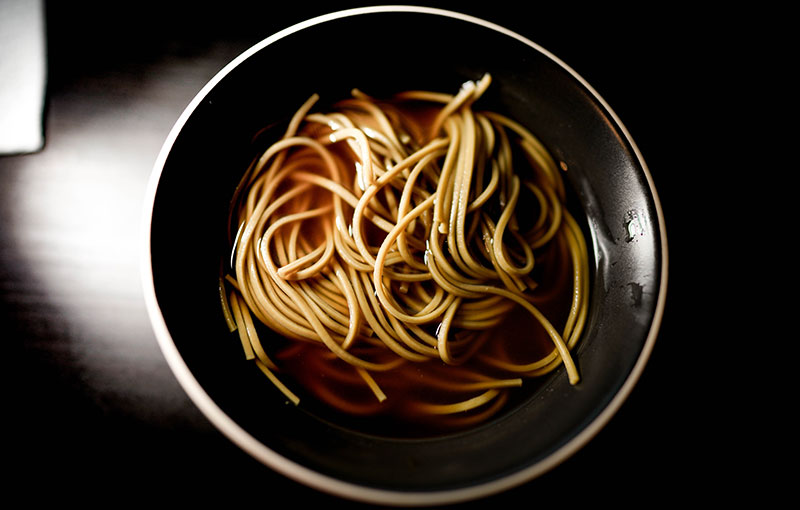
Traditionally eaten on New Year’s Eve, but now popular as a daily dish, soba noodles are made of buckwheat, or wheat and buckwheat flour. They can be found both fresh and dried – and just like other noodles, they’re served both hot and cold.
Soba noodles have an earthy and nutty flavour. They can be seasoned with a variety of foods and toppings – let’s explore the most popular soba noodle recipes.
Soba noodles are made of:
Now that you’re aware of the most popular noodles types, begin creating noodle recipes for your restaurants using Mizkan’s specially crafted vinegars and seasonings for an extra depth of flavour.
Sign up to our newsletter for all the latest news and updates within the Japanese foodservice industry and get in touch with us to find a full list of suppliers that sell our products.
What is Mirin?
Mirin is a naturally fermented Japanese sweet rice wine popular within Japanese cuisine. This clear, gold liquid is an essential in many dishes such as chicken teriyaki, ramen and udon.
The condiment is similar to sake – what differentiates the two is that mirin has more sugar and it’s mainly used for cooking, unlike sake which is also enjoyed as a drink.
Whilst it does taste a little like sake, mirin has a complex flavour of sweetness, a subtle tang yet quite a rich flavour, resulting in a lot of umami undertones balanced by mild acidity.
This blog post will help chefs understand the different types of mirin, what it’s made of, its uses and how chefs can use the condiment to experiment and add their own special touch to a range of Japanese dishes.
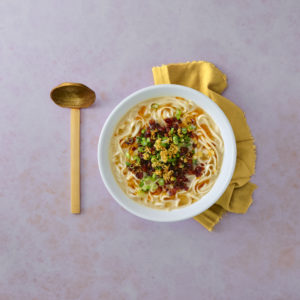
Different Types of Mirin
Mirin can come in three different types, from its purest, most authentic form to variations. Let’s explore them further:
What is Mirin Made of?
The three main pure mirin ingredients are rice, rice koji and shochu. The product is fermented from 2 months to up to several years.
Authentic mirin’s sugar is generated naturally during fermentation. Other mirin-like condiments, however, may contain artificial sweeteners.
What is Mirin Used for?
Due to its umami flavour, mirin is known to complement soy sauce in many Japanese dishes and is part of many traditional sauces such as teriyaki sauce, ponzu sauce and tempura dipping sauce.
Let’s explore what else the condiment is used for:
Best Mirin-Style Seasoning
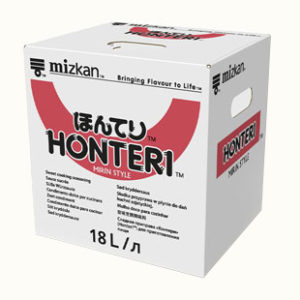
It’s generally very hard to achieve the exact flavour given by mirin through any other condiments. However, Mizkan Chef’s Honteri, a mirin-style sweet seasoning, is a high-quality product the same as mirin but with less than 0.5% alcohol content.
It contains glucose syrup, water, spirit vinegar, fermented rice alcohol, sugar and acidity regulators citric acid and cane molasses. Just like mirin, Honteri brings a unique sweetness and depth of flavour to many dishes, as well as giving them a glossy shine.
Unlike mirin, however, which must be boiled to evaporate the alcohol, Honteri contains almost no alcohol and can be used untreated so you can achieve the same complex flavour with less effort and smaller amounts.
Honteri Mirin-style Recipes
There are endless possibilities for using Honteri in Japanese and fusion dishes such as making ramen or udon noodle dishes, yakitori, marinades, salad dressings and desserts.
We have a variety of exciting dishes that contain Honteri on our recipes page – from vegetarian dishes such as agedashi tomato to meat dishes like Japanese-style turkey hambaagu.
It can also be used in drinks such as Mulled Honteri and desserts like chocolate miso cake.
For chefs looking to learn more about our high quality Honteri mirin-style seasoning and how they can purchase it for their restaurants, please get in touch with us or sign up to our newsletter for all the latest news, recipes and trends within the Japanese foodservice industry.
Sake lees, popularly called ‘sake kasu’ or ‘sake cake’, is produced as a result of the Japanese sake brewing process.
The drink is traditionally made by brewing koji (a type of fungus) into steamed rice. This causes amylase enzymes to break down the rice starch into sugar, which is then converted into alcohol by yeast.
After fermentation, rice mash is compressed to express the alcohol. The residue that remains after this process is known as sake lees.
How is sake lees used?
Due to excessive production of sake (which creates sake lees) and the Japanese ‘no waste’ culture, sake makers and chefs have found many uses of sake lees. From being used in breads, crackers, ice creams, cheesecakes and yoghurts – there are plenty of dishes and foods that sake lees can complement.
The product is also widely used in many restaurants to cut down the fishy odour in salmon and other seafood recipes such as Kasuzuke – a dish made by pickling fish (or vegetables) in sake lees.
However, what’s interesting is its use in vinegars. Sake lees is being used to create sake cake vinegar or added to a spirit vinegar, such as our Shiragiku vinegar, to give you an explosion of umami taste and vinegar tang.
What does sake lees taste like?
Sake lees is described as having a mix of sweet, savoury and umami taste, the latter is one of the five basic tastes alongside sweet, sour, bitter and salty. This flavour is found naturally in many foods including vegetables, dairy products, meat and fish.
The simple way to describe umami is that it gives a meaty and savoury deliciousness that deepens the already existing flavour in any dish, as it has a tongue-coating sensation that lasts longer than any other basic taste.
Pure sake cake vinegar vs spirit vinegar brewed with sake cake
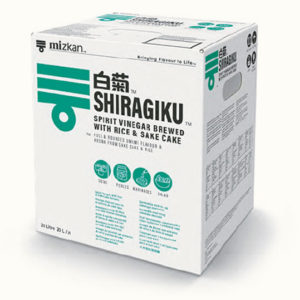
Sake lees is used on its own to create a pure sake cake vinegar or alongside other ingredients in spirit vinegars such as Shiragiku.
Pure sake cake vinegar is produced by ageing the leftover sake lees until they turn brown. The ageing process will give the vinegar a deeper, full-bodied umami flavour. The product doesn’t contain any other ingredients, which means the taste found in the vinegar is purely a result of sake lees.
While, when used in spirit vinegars like Shiragiku – sake lees’ deep umami flavour is accompanied by the mellow acidity and vinegar tang.
Why is sake cake vinegar used in Japanese cuisine?
From enhancing the taste of seafood dishes to tenderising chicken dishes like chicken teriyaki, the product has many benefits, from accentuating dishes to making them easy to chew.
Sake cake vinegar can not only be used in Japanese cuisine, but it can also be used in Mediterranean dishes such as pasta. Some ways sake cake vinegar is used include:
Use our spirit vinegar, Shiragiku, as a salad dressing such as in our Carrot Pickle Salad or as part of a sauce to intensify the flavours of other ingredients. It can also be added to broths and soups to deepen their flavour and used as a marinade in dishes like Black Belly Pork to tenderise the meat and to add a unique flavour to it.
Can I substitute sake vinegar for sake cake vinegar?
Although sake vinegar is quite popular within Japanese cuisine, it won’t give the exact deep flavour created by a pure sake cake vinegar.
The sake vinegar adds a perfect tangy flavour to a variety of dishes including dressings and marinades. However, the product can’t be used to achieve that deep umami flavour found in pure sake cake vinegars.
Mizkan’s Shiragiku however, a specially crafted spirit vinegar, can be used as a replacement of a pure sake cake vinegar as it contains leftover sake lees – which is pure sake cake vinegar’s essential and only ingredient.
Where can I find vinegar that contains sake lees?
Mizkan Chef’s Shiragiku vinegar, which is made from grain alcohol and brewed with sake lees and rice is perfect for those who want to enhance their dishes by adding a rich umami taste to them. The vinegar can be used in a variety of dishes to either enrich their flavour or to tenderise the meat and remove odour. Get in touch with us today to enquire about the product.
Check out our recipe page for inspiration on how to use Shiragiku and feel free to also sign up to our newsletter for all the latest chef news, industry trends, promotions and product information.

Mizkan Shiragiku vinegar is popular among chefs in many high-end sushi restaurants because of its distinct taste which is hard to achieve through any other vinegar. This premium product is specially crafted to bring an umami taste to a variety of Japanese dishes.
However, it can also be used within other cuisines. Whether you’re wanting to add a unique flavour into Latin American, European or Arab dishes – Shiragiku’s versatility will not disappoint you. So, let’s discover exactly what Shiragiku is, how it is brewed and what makes it so special.
What is Shiragiku?
Shiragiku is a spirit vinegar launched in Japan in 1951, the product contains alcohol and is brewed with extracts from rice and ‘sake cake lees’ (which is residue left over from the sake brewing process) to achieve a perfectly balanced umami taste.
After trialling the seasoning with various foods and dishes, Mizkan concluded that the mellow acidity of the alcohol made from rice and the richness of the sake cake complemented sushi rice and their toppings better than the traditional rice vinegars.
Shiragiku gained immense popularity across Japanese restaurants due to its sweet and rich umami tang that enhances the already existing flavour of any dish.
Shiragiku ingredients
Shiragiku, which contains 8% alcohol, is composed of five main ingredients: water, alcohol made from rice, spirit vinegar, rice and sake cake extract. The latter is what differentiates Shiragiku from all other vinegars.
Alcohol making process
Koji rice is boiled to release starches which are fermented using yeast. This results in sugar which is further fermented into alcohol.
Sake cake lees
Sake cake lees are an outcome of the Japanese sake (national alcoholic beverage) making process. During the brewing process, fermented rice mash is compressed – this expresses the sake from the mash and the residue left is called sake lees.
Shiragiku brewing process
The Shiragiku brewing process involves lees left over from the sake brewing process being aged until they get a brownish colour. The sake cake lees and rice extracts are then added to alcohol, followed by acetic acid fermentation.
Shiragiku uses
Although known for complementing sushi rice, Shiragiku can be used with almost any dish from Japanese to European cuisine, here is how the vinegar can be used:
Shiragiku recipes
Alt text: Black belly pork and pickled apple slices with Shiragiku
We have a variety of recipes from experienced chefs that have used Shiragiku vinegar – from pokes to sauces, you can find a mix of classic Japanese dishes and tasty fusion recipes.
Wondering where to start? Here are Mizkan Chef’s favourite recipes that will awake your taste buds:
Vinegared Black Belly Pork & Pickled Apple Slice – this easy-to-make recipe takes around 2 hours and 30 minutes to cook and serves 4 people. Shiragiku vinegar is used as a marinade alongside other ingredients to add an umami flavour to the pork and to tenderise the meat.
Osechi Ryori – Salmon Kombu Roll – this traditional Japanese dish, served on New Year’s Day as part of the osechi ryori feast to welcome the new year, only takes around 30 minutes to cook.
Each Osechi Ryori ingredient is carefully selected for its symbolism that carries optimistic meaning in the new year. In this case, eating kombu is believed to bring happiness for the new year.
Mizkan’s Shiragiku vinegar is used as a seasoning towards the end of the cooking process – the vinegar is added into the kombu dashi (Japanese stock soup) alongside other ingredients and left to cook for 5 minutes before turning the heat off and letting it sit for about an hour before being served.
From the unique ingredient that makes Shiragiku what it is today to its adaptability to any dish – the art of crafting Shiragiku cannot be undermined. Try the vinegar yourself with any sweet or savoury Japanese or European recipe and explore the distinct taste Shiragiku vinegar brings to your dishes.
You can get the product by contacting us or, for the latest chef news, recipes and trends within the food industry sign up to our newsletter.
It was thought that there were only four basic tastes: sweet, salty, sour, and bitter. Umami, however, is the fifth basic taste that may be difficult to identify in European, Latin American and Middle Eastern cuisines as it is mostly common within the Japanese cuisine.
Whilst experienced chefs will know and understand the concept of umami, let’s recap its definition and how to achieve it in a variety of fusion dishes; helping you, as chefs, to mix Japanese and European ingredients to create dishes that have a perfectly balanced umami flavour.
What is Umami?
Umami refers to the taste of glutamate, an amino acid that is one of the building blocks of protein found in the human body, meat, and vegetables.
What does umami mean? The word itself, umami, derives from Japan and when translated it means ‘pleasant savoury taste’.
Meat and fish such as pork, cured meats, steak, and salmon have a base umami taste. This unique flavour can also be found in vegetables such as tomatoes, cabbage, mushrooms, and other everyday foods such as mature cheese and green tea.
However, the umami taste is more subtle than other tastes as it always comes alongside other flavours and never found by itself naturally like the sweet (found in honey and most fruits like dates and pineapple) or sour (found in citrus fruits, tamarind, cranberries) flavours.
Often described as the essence of deliciousness, the taste is particularly popular in Japanese cuisine due to use of foods that contain high levels of glutamate which give the dishes this deep, umami taste. Use Mizkan’s specialised vinegar Shiragiku or our Honteri mirin-style seasoning to bring this complex delicious umami flavour into your fusion dishes.
What does Umami taste like?
Umami is described as having a savoury, meaty deliciousness that deepens other flavours. In simple words, it tastes like broths and cooked meats.
The taste derives from the amino acids glutamate and ribonucleotides. The umami sensation comes after the detection of the carboxylate anion of glutamate in the receptor cells present in the human body.
The umami flavour is not desired on its own as it is not so tasty. However, when paired with other ingredients, it intensifies their flavour.
Where is Umami located on the tongue?
Add graphic image showing where the taste is located – if possible
Umami is a mild taste that stimulates the throat, the roof, and the back of the mouth. It has a lasting aftertaste associated with salivation and a feeling of furriness on the tongue.
Umami foods
Umami is found in many organic foods with high glutamate levels such as seaweed, soya beans, yeast extract, many types of seafood, garlic, truffle oil and green peas. However, it is also found in fermented and processed foods such as marmite, ketchup, dried, aged, and processed meats, sake cake vinegars and oyster sauce.
Proteins like pork, fish, beef and shellfish make strong umami foundations – so combining them with other ingredients that have high levels of umami flavour will give you an umami explosion, perfect for those that love this particular taste.
Check out our recipes page for Japanese and fusion recipes containing the deep umami flavour like our black belly pork made with Shiragiku vinegar or our miso butter karaage chicken made with our Honteri mirin-style seasoning.
How was umami discovered?
Umami was first identified as a taste in 1908 in Japan by Dr. Kikunae Ikeda, a chemist who was eating a kelp broth called kombu dashi in which he noticed that the savoury flavour was different from the four basic tastes, something he had never experienced before.
After researching, he concluded that umami wasn’t a biproduct of the other four basic tastes, instead it was a distinctive, unique taste.
However, it was in 1985 when umami was internationally recognised as a scientific term to describe the taste of glutamates. While in 2002, the umami taste receptors were identified on the human tongue, indicating that it is an inherent taste that is enjoyed universally.
What makes umami unique?
There is no doubt that umami is a unique and complex flavour. So, let’s find out what makes umami different from other core tastes:
When thinking of the umami flavour, Japanese cuisine is what comes to mind first. However, there is no doubt that the taste can be enjoyed with other world cuisines such as Pan-Asian, Middle Eastern, Mexican, and even Mediterranean dishes.
To learn more about achieving the umami taste, sign up to our newsletter and get the latest chef news, recipes, product information and promotions straight to your inbox, so you never miss an update.
Are you a chef looking to get into Japanese cuisine or just want to explore different flavours and mix them within your European, Latin American, Pan-Asian or even Middle Eastern cuisine?
Getting into a new cuisine and sourcing the ingredients required to make a new dish can be challenging if you aren’t familiar with the ingredients. This guide will walk you through some essential Japanese ingredients every chef must have in their kitchen.
Just like any world cuisine, Japanese cuisine has a group of core ingredients that are used in nearly all dishes.
These ingredients can not only be used together to create a variety of delicious Japanese dishes and used on their own as sauces and toppings – but they can also be mixed with other world-famous ingredients to create fusion recipes.
So, let’s find out all the must-have Japanese ingredients every fusion chef needs in their kitchen.
Soy Sauce
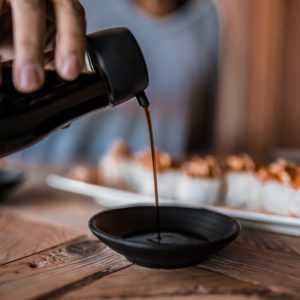
Let’s start off with a simple yet basic ingredient that isn’t only popular in Japanese cuisine, but it’s also widely used to complement western dishes such as braised beef with mixed vegetables or the popular tomato and basil pasta sauce.
Soy sauce is Japanese cuisine’s most basic flavour that goes well with almost everything. It’s not only used as a base ingredient in broths and soups, but it’s also widely used as a sauce for dips, dressings and marinades.
The ingredient is made of boiled soybeans, wheat, salt, and water. The soybeans and wheat are fermented together for a couple of days and then water and salt are added in and left for long periods of time. This traditional fermenting process takes months and often years.
Not all Japanese soy sauces are the same. Different amounts of salt, soybeans, wheat, and brewing time can impact the final flavour. However, there are two main types of soy sauces:
Rice Vinegar
Rice vinegar can be used for seasoning rice, for pickling, in marinades, sauces, salad dressings and even in cocktails. The product is generally less acidic than many western vinegars such as the balsamic and red wine vinegars.
The ingredient is made by fermenting boiled koji rice starches using yeast. The yeast then converts the sugar from the rice into alcohol and eventually becomes rice vinegar after acetic acid fermentation. High quality rice vinegars usually take weeks and even months to make as they are fermented traditionally to create a distinct flavour.
Mizkan’s rice vinegar Yumai is light in colour, has a clear aroma as it is only made from rice, rich flavour and mellow acidity – an essential in all Japanese kitchens. The ingredient does not only complement sushi dishes, but it can complement a variety of warm and cold dishes such as stir-fries soups and broths, salad dressings, sauces and desserts.
Spirit Vinegar

If you’re looking for a spirit vinegar that has a profound umami and rice flavour, then Mizkan’s Shiragiku is exactly what you’re looking for.
The Shiragiku brewing process consists of sake lees being matured until they get a brownish shade. Rice extract, fresh sake lees and matured sake lees is then cooked together followed by enzyme fermentation which results in the final product.
Usually slightly darker than standard spirit vinegar, Shiragiku has a rich, umami-like taste which makes it popular in high-end sushi restaurants.
The ingredient goes extremely well with pickling, marinades, stir-fries, salad dressings and even cocktails. Check out a variety of our recipes such as black belly pork or our scallops with asparagus, rhubarb and pickles to find out exactly how the ingredient is used in different dishes.
Mirin
You may have noticed that many Japanese dishes have an umami taste, sweetness and a subtle tang which is often hard to place – the secret behind this complex flavour is Mirin.
One of the most enchanting ingredients of Japanese seasoning elements, Mirin is often used as a sugar replacement to add a complex sweetness to any dish.
Just like sake, mirin is an alcoholic ingredient (contains 12% alcohol) made from koji rice fermented for few months up to several years. What differentiates the two is mirin having a sweeter taste and lower alcohol levels compared to sake.
However, if you’re looking for a mirin-style ingredient that has even lower levels of alcohol than mirin, our Mizkan Honteri Mirin style is the perfect substitute. The seasoning has the same flavour profile but with almost no alcohol – only 0.5%, which is equivalent to the percentage of alcohol in a ripe banana.
Honteri consists of spirit vinegar and sweet rice wine. It adds a complex roundness to a variety of cuisines, but with the convenience of not having to be boiled to evaporate the alcohol. It works well with both savoury and sweet dishes like our salmon tartare bites or the fluffy Japanese pancakes.
Miso
Miso consists of a thick paste with a soft spreadable consistency made from fermented soybeans and koji.
For a very long time, this ingredient was unknown outside of Japan, but with an increasing interest in Japanese cuisine it’s now widely known and used in the west.
Apart from miso soup, the paste is used in many dishes. However, that depends on the type of miso paste as different variations pair well with different foods. There are two main types:
Sushi Rice
Sushi rice also known as Japanese rice is the most important Japanese ingredient as it is used in many dishes such as sushi, onigiri and curry. Unlike Indian and Chinese rice, Japanese rice has short pebble-shaped grains that when cooked release starch that sticks the rice together.
That is why this type of rice is perfect for sushi as it clumps together which makes it easier to eat with chopsticks. Learn how to make sushi rice through our step-by-step video guide.
Apart from being used with sushi, Japanese rice is served alongside a variety of other dishes such as curries and pokes.
Noodles
Another widely consumed ingredient in Japanese cuisine are noodles. They come in many different types depending on the variety of dishes they are used in.
For example, they are used in soups to make dishes such as the Ramen Tonkotsu Soup or in stir-fried dishes such as Maze Tantan Men. However, the three most popular noodle types are:
Wasabi
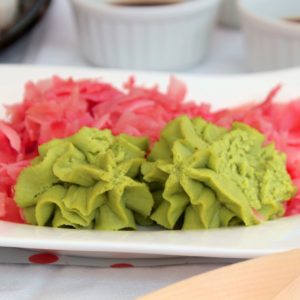
Real wasabi is made of wasabi root which is very expensive as it’s extremely difficult to farm correctly. The majority of wasabi paste we see in supermarkets is made of horseradish, which is closely related to the wasabi root.
This green paste that we often find with sushi is made by grating the horseradish root and mixing oil, water, and green coloured dye. Like all the ingredients mentioned in this blog, wasabi is also widely used within Japanese dishes, from being paired with boiled eggs to being used with chicken or seafood.
Finally, these ingredients are the foundation of Japanese cuisine and without any one of these, there would be no authentic Japanese dish.
Any chef, specifically those involved in European cuisine, can use these ingredients to create exciting fusion recipes.
To find out where you’ll be able to get products with a rich umami taste like vinegars containing sake lees or sweeter, more complex flavours such as Honteri Mirin style seasoning – get in touch with us today and you’ll soon be ready to cook a variety of delicious dishes.